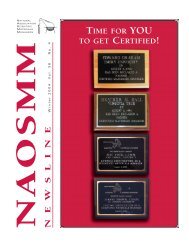Laboratory Safety Guidance
OSHA Lab Safety Guidance - ORS Optical Remote Sensing ...
OSHA Lab Safety Guidance - ORS Optical Remote Sensing ...
- No tags were found...
You also want an ePaper? Increase the reach of your titles
YUMPU automatically turns print PDFs into web optimized ePapers that Google loves.
Other Governmental and Nongovernmental<br />
Agencies Involved<br />
in <strong>Laboratory</strong> <strong>Safety</strong><br />
U.S. Environmental Protection Agency<br />
(EPA)<br />
Microbial Products of Biotechnology:<br />
Final Rule (62 FR 17910)<br />
The regulation under which the TSCA Biotechnology<br />
Program functions is titled "Microbial Products of<br />
Biotechnology; Final Regulation Under the Toxic<br />
Substances Control Act" (TSCA), published in the<br />
Federal Register on April 11, 1997. This rule was<br />
developed under TSCA Section 5, which authorizes<br />
the Agency to, among other things, review new<br />
chemicals before they are introduced into commerce.<br />
Under a 1986 intergovernmental policy statement,<br />
intergeneric microorganisms (microorganisms created<br />
to contain genetic material from organisms in<br />
more than one taxonomic genus) are considered new<br />
chemicals under TSCA Section 5. The Biotechnology<br />
rule sets forth the manner in which the Agency will<br />
review and regulate the use of intergeneric microorganisms<br />
in commerce, or commercial research.<br />
Documents relevant to this rule can be found at the<br />
following web site:<br />
http://www.epa.gov/oppt/biotech/pubs/biorule.htm.<br />
U.S. Nuclear Regulatory Commission<br />
(NRC)<br />
10 CFR 31.11 – General license for use of byproduct<br />
material for certain in vitro clinical or laboratory testing.<br />
Link at: http://www.nrc.gov/reading-rm/doc-collections/cfr/part031/part031-0011.html.<br />
U.S. Department of Transportation (DOT)<br />
An infectious substance is regulated as a hazardous<br />
material under the DOT’s Hazardous Materials<br />
Regulations (HMR; 49 CFR Parts 171-180). The HMR<br />
apply to any material DOT determines is capable of<br />
posing an unreasonable risk to health, safety, and<br />
property when transported in commerce. An infectious<br />
substance must conform to all applicable HMR<br />
requirements when offered for transportation or<br />
transported by air, highway, rail, or water.<br />
DOT’s Pipeline and Hazardous Materials <strong>Safety</strong><br />
Administration (PHMSA) published a final rule on<br />
June 1, 2006, revising the requirements in the HMR<br />
applicable to the transportation of infectious substances.<br />
The new requirements became effective<br />
October 1, 2006. Changes under the new rule apply to<br />
parts 171, 172, 173, and 175 of the HMR and include<br />
the following:<br />
• New classification system<br />
• New and revised definitions<br />
• Revised marking requirements<br />
• Revised packaging requirements<br />
• New shipping paper requirements<br />
• New security plan requirements<br />
• New carriage by aircraft requirements<br />
A guide to these changes is available at:<br />
http://www.phmsa.dot.gov/staticfiles/PHMSA/<br />
DownloadableFiles/Files/Transporting_Infectious_<br />
Substances_brochure.pdf.<br />
U.S. Department of Health and Human<br />
Services (HHS)<br />
Centers for Disease Control and Prevention<br />
(CDC)<br />
Biosafety Levels<br />
<strong>Laboratory</strong> supervisors are responsible for ensuring that<br />
appropriate safety and health precautions are in place in<br />
the laboratory. Therefore, for each biosafety level, there<br />
are specific supervisory qualifications as assurance that<br />
laboratory workers are provided with effective supervision.<br />
Various types of specialized controls and equipment<br />
are used to provide primary barriers between the<br />
microorganism and the laboratory worker. These range<br />
from disposable gloves and other PPE to complex<br />
biosafety cabinets or other containment devices.<br />
The laboratory director is specifically and primarily<br />
responsible for the safe operation of the laboratory.<br />
His/her knowledge and judgment are critical in<br />
assessing risks and appropriately applying these recommendations.<br />
The recommended biosafety level<br />
represents those conditions under which the agent<br />
can ordinarily be safely handled. Special characteristics<br />
of the agents used, the training and experience of<br />
personnel, and the nature or function of the laboratory<br />
may further influence the director in applying these<br />
recommendations.<br />
The U.S. Department of Health and Human Services’<br />
(DHHS) Centers for Disease Control and Prevention<br />
(CDC) defines four levels of biosafety, which are outlined<br />
below. Selection of an appropriate biosafety<br />
level for work with a particular agent or animal study<br />
(see Animal Facilities) depends upon a number of factors.<br />
Some of the most important are the virulence,<br />
pathogenicity, biological stability, route of spread, and<br />
communicability of the agent; the nature or function<br />
of the laboratory; the procedures and manipulations<br />
involving the agent; the endemicity (restricted to a<br />
locality/region) of the agent; and the availability of<br />
effective vaccines or therapeutic measures.<br />
4 0<br />
Occupational <strong>Safety</strong> and<br />
Health Administration



